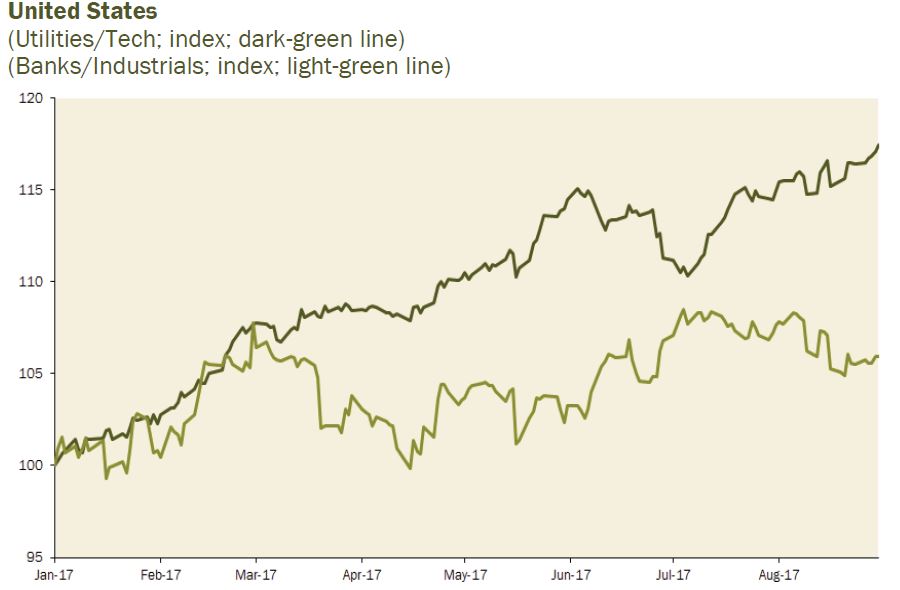Recently there has been much discussion comparing President Trump's economic policies today to President Reagan's policies in the early 1980's - supply side economics. There is still debate today on if the supply side policies worked in the 1980's or whether the normal course of the economic cycle (falling interest rates once inflation was defeated) led to the economic recovery in the mid-1980's.
President Trump's policies call for aggressive corporate tax cuts and significantly reduced business regulations, with the assumption that businesses will spend the savings on re-investing through hiring and capital expenditures, spurring overall economic activity and raising government tax revenues. Time will tell; however, we believe the biggest factor being ignored is the context of demographics and the U.S. economic state in comparing 1981 to 2017.
OUTLOOK 2017 chart highlights key differences between the start of the two Presidential terms.
| Reagan | Trump | |
|---|---|---|
| Demographics (age 19-34) | ~41% | ~31% |
| Interest Rates | 20% | 0.75% |
| Debt-to-GDP | 32% | 105% |
| Unemployment | 7.5% | 4.7% |
| Borders | Opening | Closing |
| Price/Earnings | 8x | 20x |
First, the change in retirement demographics is significant. The greying of America has a large impact on spending patterns since we know that as people retire, they consume less and save more.
Second, interest rates were at an all-time high in 1981 and dropped rapidly compared to today when they are at all time lows and can only go higher, likely slowing economic growth regardless of proposed tax cuts.
Third, over the last 35 years debt to gross domestic product (GDP) has increased sharply from 32% to 105% which means every government dollar spent has less impact on the economy than in the past.
Fourth, unemployment in 1981 was at 7.5% vs 4.3%, a decade low today and close to what many economists consider full employment.
Fifth, borders were opening and walls coming down as opposed to today.
Finally, the valuation of the S&P 500 Index was eight times forward earnings in 1981 vs 20 times today, meaning the overall stock market is fairly valued today compared to the depressed level in 1981.
Bottom Line
Although pundits are calling President Trump's tax policies the key driver to jump-start economic growth significantly, we believe they are missing key economic and demographic context, as well as the massive technological disruptions driving change. Moreover, as a result, these policies may not achieve the "glory days" of the President Reagan era.
In the words of David Rosenberg:
"Investors should be hesitant to connect-the-dots' all the way to the presidency." - Referring to America's economic growth happening naturally from the people, and not from Trump's direction.
"For all the talk about reflationary animal spirits since the November election, we looked at two barbell portfolios - the pro-Trump and anti-Trump portfolios. The pro-Trump barbell includes the Financials (deregulation and the benefits from reflation causing the Fed to raise rates) and the Industrials (infrastructure and tax reform). The anti-Trump barbell includes Utilities (which tend to lag far behind with fiscal reflation and rising bond yields) and Technology (a group that was supposed to succumb both to Donald Trump's wrath since Silicon Valley voted overwhelmingly against him - those pinko/leftos - not to mention be hurt by protectionist trade policies and anti-immigration stances).
Now, while the former got a big head start in the weeks following the election, look at what has happened so far this year. The anti-Trump barbell is up 17.3% and has outperformed the pro-Trump barbell by 1,090 basis points - the latter is no higher today than it was back in early March."
Chart: The Anti-Trump Barbell Continues to Outperform.

When reviewing the chart above, we reinforce our confidence in the decision to continue with our key-themes and endurable trends.
Key-Themes:
- Disruptive Technology
- Global Instability/Cyber
- Ageing Demographic
In summary; we follow our portfolio, not Trumps.
Believing in a Collaborative Economy
Passionately leading business toward a better world and a collaborative economy.